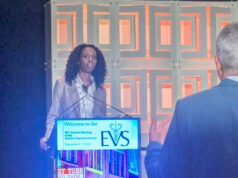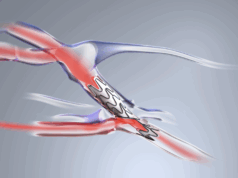 The fourth annual Hamburg Dialysis Access Symposium (23–24 September, Hamburg, Germany) was recently organised and moderated by Robert Shahverdyan (Asklepios Clinic Barmbek, Hamburg, Germany), who also presented. He reports for Renal Interventions on the event, which also included a hands-on workshop including live transmission of three endovascular arteriovenous fistula (endoAVF) creation cases with the Ellipsys (Medtronic) and WavelinQ (BD) devices for endovascular arteriovenous fistula (endoAVF) creation. He writes here on the most salient takeaways from the presentation.
The fourth annual Hamburg Dialysis Access Symposium (23–24 September, Hamburg, Germany) was recently organised and moderated by Robert Shahverdyan (Asklepios Clinic Barmbek, Hamburg, Germany), who also presented. He reports for Renal Interventions on the event, which also included a hands-on workshop including live transmission of three endovascular arteriovenous fistula (endoAVF) creation cases with the Ellipsys (Medtronic) and WavelinQ (BD) devices for endovascular arteriovenous fistula (endoAVF) creation. He writes here on the most salient takeaways from the presentation.
This year’s symposium included speakers not only renowned in Germany but also internationally. The symposium was opened by a presentation from Maurizio Gallieni (University of Milan, Milan, Italy), who gave a talk on the importance of guidelines in dialysis access. He noted that there were guidelines available from several different societies, including the European Society for Vascular Access (ESVS) guidelines from 2018 and the updated Kidney Disease Outcomes Quality Initiative (KDOQI) guidelines from 2019, but said that there were slight differences between them. The available evidence in dialysis access in general is scarce, he said, especially with regards to the randomised controlled trials and number of patients included in the publications, and he advised everyone to collect and submit high quality data from their experience to related journals. One journal highly associated with dialysis access, is, of course, the Journal of Vascular Access (JVA), which is distinguished by a relatively fast review process.
Volume flow and access implications
Followed by several talks about the low incidence of home haemodialysis and relatively low incidence of peritoneal dialysis, Clemens Weinberg (Asklepios Clinic Barmbek, Hamburg, Germany) talked about the incidence and prevalence of tunnelled dialysis catheters (TDC) in Hamburg, Germany. The key message he gave was that, even though around 50% of patients referred to dialysis access creation in Hamburg are end-stage kidney disease (ESKD) patients with an indwelling tunnelled dialysis catheter, having an early plan for “crash-landers” already at the time of the TDC placement is crucial: saving the veins, creating an early vascular access, starting early cannulations. These are crucial to remove the TDC as soon as possible to reduce the unnecessary risk of catheter associated infections and central venous obstructions. In addition to that, Theodore Saad (Nephrology Associates, Newark, USA) talked about the implications of volume flow and long-term dialysis access on a patient’s heart. Whether the vascular access should be preserved or abandoned, or whether flow reduction should be performed after successful kidney transplant in ESKD patients, remains an open debate.
EndoAVF and cannulation
I was among those who spoke at the second session, which started with presentations about the role and importance of innovations in dialysis access such as the VasQ external support device (Laminate Medical), early cannulation grafts and endoAVFs. President of the Vascular Access Society, David Shemesh (Shaare Zedek Medical Center, Jerusalem, Israel), and Dominik Liebetrau (University Hospital Augsburg, Augsburg, Germany) also spoke, before a keynote lecture of the Symposium was presented by Julius Kunow (Diaverum Alter Teichweg, Hamburg, Germany). Talking about the challenges and difficulties of adapting endoAVFs for cannulations at his dialysis center, Kunow remarked that being open to innovations, showing trust in vascular access surgeons in the choice of creating the best possible dialysis access for the patients, as well as the role of ultrasound-guided cannulations in the first stage of endoAVF cannulations, have lead to successful cannulations and more satisfied patients and clinicians.
Building on the previous presentation, one whole session was dedicated to the importance of the cannulations of arteriovenous fistulas (AVFs). Pascal Kopperschmidt (Fresenius Medical Care, Bad Homburg, Germany), himself a dialysis patient of decades, reported on his experience of buttonhole cannulations, the challenges associated with learning how to cannulate, and, mostly importantly, the hygienic perspective of avoiding the risk of infection.
Getting the right angle of cannulation for dialysis access, as well as routine use of point-of-care-ultrasound (POCUS) during cannulation, can reduce the risk of associated backward penetration, hematomas and eventually dialysis access failure, said experienced dialysis nurses Kathleen Rickert and Beate Spindler (Asklepios Clinic Barmbek, Hamburg, Germany). Rickert stressed during the post-presentation discussion that adopting ultrasound-guided cannulations in every dialysis unit should be the expectation and not the exception.
The patient perspective
In the next session, I spoke on getting the right access for the right patient alongside nephrologist Haimanot Wasse (RUSH Medical College, Chicago, USA), and dialysis patient Stefanie Neuhäuser from Cologne, Germany, each offering our own perspectives on access choice. One of our key messages was that the patient’s decision should always be considered by a multidisciplinary team prior to any decision on dialysis access modality.
Finally, a whole session was dedicated to the maintenance of dialysis access dysfunction. Wasse presented again, this time on access dysfunction caused by cephalic arch stenosis. She examined the challenges of both endovascular and surgical treatments for the condition, their possible treatment algorithms, as well as tips and tricks on using balloons or stent grafts for the issue.
All presentations were followed by individual discussions and Q&As. I found the symposium both educational and interactive for its more than 80 participants from Hamburg and across Germany. They were exposed to presentations on both conventional and innovative dialysis access modalities, while we also explored cannulation and the maintenance of several complex problems related to dialysis access. We look forward to our next, fifth Symposium, on 8-9 September 2023.
Disclosures:
Receipt of honoraria or consultation fees from Becton Dickinson and Company, Bluegrass Vascular Technologies, Laminate Medical Inc. and Medtronic,
Participation in a company sponsored speaker’s bureau: W.L. GORE, BrosMed Medical











